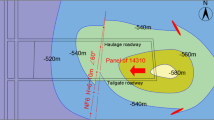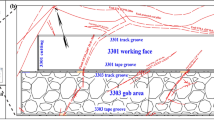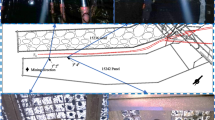Abstract
In the mining process of a coal seam containing a fault structure, due to the influence of mining stress, the rock mass inside the fault zone and between the fault and the coal pillar that is preserved to prevent fault activation is prone to producing damage and activation. This study is focused on this problem. Based on the analysis of the failure, activation and movement of the rock mass in front of the fault body and the coal wall, extended finite element numerical simulation software is adopted to study the stress evolution and deformation failure rules of a coal seam containing a fault floor. In particular, the dynamic response process (including slip velocity, slip distance and friction force) of the fault structure under mining conditions is monitored, and then the turning and failure process of the fault structure is analysed. However, an analogue modelling is reformed. A similar material analysis model is established to monitor the displacement field changes near the fault during the mining process, obtain the movement rules of the fault zone and surrounding rock mass during the mining process, and then verify the reliability of the numerical simulation results. The research results can provide references for exploring the coupling movement rules between the fault and the work area for production in the mining process of coal seam stopes, as well as prevention before water inrush under the influence of the fault and treatment after water inrush.















Similar content being viewed by others
References
Brace, W. F., Byerlee, J. D. (1966). Stick-slip as a mechanism for earthquakes. Science, 153(3739), 990–992. https://www.jstor.org/stable/1719360
Bu, W. K., & Mao, X. B. (2009). Research on effect of fault dip on fault activation and water inrush of coal floor. Chinese Journal of Rock Mechanics and Engineering, 28(02), 386–394.
Chen, J. T., Yin, L. M., Sun, W. B., Lu, C., Zhang, S. C., & Sun, X. Z. (2015). Development and application for new solid-fluid coupling similar material of deep floor aquifuge. Chinese Journal of Rock Mechanics and Engineering, 34(S2), 3956–3964.
Chen, J., Zhao, J., Zhang, S., Zhang, Y., Yang, F., & Li, M. (2020). An experimental and analytical research on the evolution of mining cracks in deep floor rock mass. Pure and Applied Geophysics, 177(11), 5325–5348.
Euser, B., Rougier, E., Lei, Z., Knight, E. E., Frash, L. P., Carey, J. W., Viswanathan, H., & Munjiza, A. (2019). Simulation of fracture coalescence in granite via the combined finite-discrete element method. Rock Mechanics and Rock Engineering. https://doi.org/10.1007/s00603-019-01773-0
Gong, P. L., HuY, Q., & Zhao, Y. S. (2005). Three-dimensional simulation study on law of deformation and breakage of coal floor on mining above aquifer. Chinese Journal of Rock Mechanics and Engineering, 24(23), 4396–4402.
Guo, W. J., Zhao, J. H., Yin, L. M., & Kong, D. Z. (2017). Simulating research on pressure distribution of floor pore water based on fluid-solid coupling. Arabian Journal of Geosciences, 10(1), 1–14. https://doi.org/10.1007/s12517-016-2770-6
Jha, B., & Juanes, R. (2014). Coupled multiphase flow and poromechanics: a computational model of pore pressure effects on fault slip and earthquake triggering. Water Resources Research, 50(5), 3776–3808. https://doi.org/10.1002/2013WR015175
Jiang, J. Q., Wang, P., Jiang, L. S., Zheng, P. Q., & Feng, F. (2018). Numerical simulation on mining effect influenced by a normal fault and its induced effect on rock burst. Geomechanics and Engineering, 14(4), 337–344.
Jiang, J. Q., Wu, Q. L., & Qu, H. (2015). Characteristic of mining stress evolution and activation of the reverse fault below the hard-thick strata. Journal of China Coal Society, 40(2), 267–277.
Jiang, Y. D., Wang, T., Zhao, Y. X., & Wang, C. (2013). Numercial simulation of fault activation pattern induced by coal extraction. Journal of China University of Mining and Technology, 42(1), 1–5.
Jiao, Z. H., Jiang, Y. D., Zhao, Y. X., Zhang, M., & Hu, H. (2019). Dynamic mechanical response characteristics of working face through fault. Journal of China University of Mining and Technology, 48(01), 54–63.
Karatela, E., & Taheri, A. (2018). Three-dimensional hydro-mechanical model of borehole in fractured rock mass using discrete element method. Journal of Natural Gas Science and Engineering, 53, 263–275. https://doi.org/10.1016/j.jngse.2018.02.032
Li, B., & Wu, Q. (2019). Catastrophic evolution of water inrush from a water-rich fault in front of roadway development: a case study of the hongcai coal mine. Mine Water and the Environment, 38(2), 421–430.
Li, L. C., Tang, C. A., Li, G., & Yang, T. H. (2009). Damage evolution and delayed groundwater inrush from micro faults in coal seam floor. Chinese Journal of Geotechnical Engineering, 31(12), 1838–1844.
Li, S., Zhou, Y., & Li, L. (2012). Development and application of a new similar material for underground engineering fluid-solid coupling model test. Chinese Journal of Rock Mechanics and Engineering, 31(6), 1128–1137.
Li, X. Z., Zhang, G. Y., & Luo, G. Y. (2003). Barrier effects caused by fault on excavating-induced stress and edformation and mechanism of resulting groundwater inrush. Rock and Soil Mechanics, 24(02), 220–224.
Liu, Q. S., Zhang, W., Lu, X. L., & Fu, J. J. (2010). Safety monitoring and stability analysis of arge-scale roadway in fault fracture zone. Chinese Journal of Rock Mechanics and Engineering, 29(10), 1954–1962.
Liu, Z. J., & Hu, Y. Q. (2007). Solid-liquid coupling study on water inrush through faults in coal mining above confined aquifer. Journal of China Coal Society, 32(10), 1046–1050.
Meng, Z. P., Peng, S. P., Feng, Y., & Lei, Z. Y. (2006). Influence of fracture structure plane on underground pressure and roof stability of working face. Coal Geology and Exploration, 34(03), 24–27.
Mottahedi, A., & Ataei, M. (2019). Fuzzy fault tree analysis for coal burst occurrence probability in underground coal mining. Tunnelling and Underground Space Technology, 83, 165–174.
Munoz, H., Taheri, A., & Chanda, E. K. (2016). Pre-peak and post-peak rock strain characteristics during uniaxial compression by 3D digital image correlation. Rock Mechanics and Rock Engineering, 49(7), 2541–2554.
Song, D. Z., Wang, E. Y., & Li, Z. H. (2017). EMR: an effective method for monitoring and warning of rock burst hazard. Geomechanics and Engineering, 12(1), 53–69.
Song, Z. Q. (2003). Research on dynamic information basis for prediction and control of major accidents in coal mines. Coal industry press.
Song, Z. Q., Hao, J., Tang, J. Q., & Shi, Y. K. (2013). Study on water inrush from faults prevention and control theory. Journal of China Coal Society, 38(9), 1511–1515.
Sun, W. B., Zhang, S. C., Li, Y. Y., & Lu, C. (2015). Development application of solid-fluid coupling similar material for floor strata and simulation test of water inrush in deep mining. Chinese Journal of Rock Mechanics and Engineering, 34(s1), 2665–2670.
Sweetenham, M. G., Maxwell, R. M., & Santi, P. M. (2017). Assessing the timing and magnitude of precipitation-induced seepage into tunnels bored through fractured rock. Tunnelling and Underground Space Technology, 65, 62–75.
Wang, Q., Gao, H. K., Yu, H. C., Jiang, B., & Liu, B. H. (2019). Method for measuring rock mass characteristics and evaluating the grouting-reinforced effect based on digital drilling. Rock Mechanics and Rock Engineering Rock, 52(3), 841–851.
Xiao, G. F., & Chen, C. X. (2018). Simulation of progressive failure process and stability analysis method for rock block. Rock and Soil Mechanics, 39(8), 292–301.
Xing, H., & Makinouchi, A. (2003). Finite element modelling of frictional instability between deformable rocks. International Journal for Numerical and Analytical Methods in Geomechanics, 27, 1005–1025.
Xing, H. L., Makinouchi, A., & Mora, P. (2007). Finite element modeling of interacting fault systems. Physics of the Earth Interiors Planetary, 163(1–4), 106–121.
Xing, H., & Mora, P. (2006). Construction of an intraplate fault system model of South Australia, and simulation tool for the iSERVO institute seed project. Pure and Applied Geophysics, 163, 2297–2316.
Xing, H. L., Mora, P., & Makinouchi, A. (2004). Finite element analysis of fault bend influence on stick-slip instability along an intra-plate fault. Pure Geophysics Applied, 161(9–10), 2091–2102.
Xing, H., Mora, P., & Makinouchi, A. (2006). A unified friction description and its application to the simulation of frictional instability using the finite element method. Philosophical Magazine, 86, 3453–3475.
Xing, H., & Xu, X. (2011). M8. 0 Wenchuan earthquake. Springer.
Yamada, Y., Yoshimura, N., & Sakurai, T. (1968). Plastic stress-strain matrix and its application for the solution of elastic-plastic problems by finite element method. International Journal of Mechanical Sciences, 10, 343–354.
Yu, M. H. (1994). Unified strength theory for geomaterials and its application. Chinese Journal of Geotechnical Engineering, 16(2), 1–10.
Yu, M. H. (2007). Linear and nonlinear unified strength theory. Chinese Journal of Rock Mechanics and Engineering, 26(4), 662–669.
Zhang, J., Li, S. C., & Li, L. P. (2017). Grouting effects evaluation of water-rich faults and its engineering application in Qingdao Jiaozhou Bay Subsea Tunnel, China. Geomechanics and Engineering, 12(1), 35–52.
Zhao, J., Chen, J., Zhang, X., Jiang, N., & Zhang, Y. (2020b). Distribution characteristics of floor pore water pressure based on similarity simulation experiments. Bulletin of Engineering Geology and the Environment, 79(9), 4805–4816. https://doi.org/10.1007/s10064-020-01835-6
Zhao, J. H., Jiang, N., Yin, L. M., & Bai, L. Y. (2018a). The effects of mining subsidence and drainage improvements on a waterlogged area. Bulletin of Engineering Geology and the Environment, 78(5), 3815–3831. https://doi.org/10.1007/s10064-018-1356-9
Zhao, J., Li, B., Chen, J., & Jiang, N. (2020c). Mechanism of seepage-stress fault water inrush and grouting seal. Arabian Journal of Geosciences. https://doi.org/10.1007/s12517-020-05319-5
Zhao, J. H., Yin, L. M., & Guo, W. J. (2018b). Stress–seepage coupling of cataclastic rock masses based on digital image technologies. Rock Mechanics and Rock Engineering, 51(8), 2355–2372.
Zhao, J., Zhang, X., Ning, J., Yin, L., & Guo, W. (2020a). Porosity characteristics of fault floor under fluid-solid coupling. Bulletin of Engineering Geology and the Environment, 79(5), 2529–2541. https://doi.org/10.1007/s10064-019-01701-0
Acknowledgements
Funding was provided by the National Natural Science Foundation of China (52104203); Shandong Province Natural Science Foundation Project (ZR2020QE128); National Key R&D Program of China (2018YFC0604705); SDUST Research Fund (grant 2018TDJH102); National Natural Science Foundation of China (Grant nos. 51574159, 52074251, 51974172, 51974173, 92058211 and 51804179); Central Universities (No. 842012003), and 111 project (No. B20048). Central Universities (No. 842012003), and 111 project (No. B20048).
Author information
Authors and Affiliations
Corresponding author
Additional information
Publisher's Note
Springer Nature remains neutral with regard to jurisdictional claims in published maps and institutional affiliations.
Rights and permissions
About this article
Cite this article
Zhao, J., Juntao, C., Huilin, X. et al. Dynamic Mechanical Response and Movement Evolution Characteristics of Fault Systems in the Coal Mining Process. Pure Appl. Geophys. 179, 233–246 (2022). https://doi.org/10.1007/s00024-021-02905-w
Received:
Revised:
Accepted:
Published:
Issue Date:
DOI: https://doi.org/10.1007/s00024-021-02905-w




